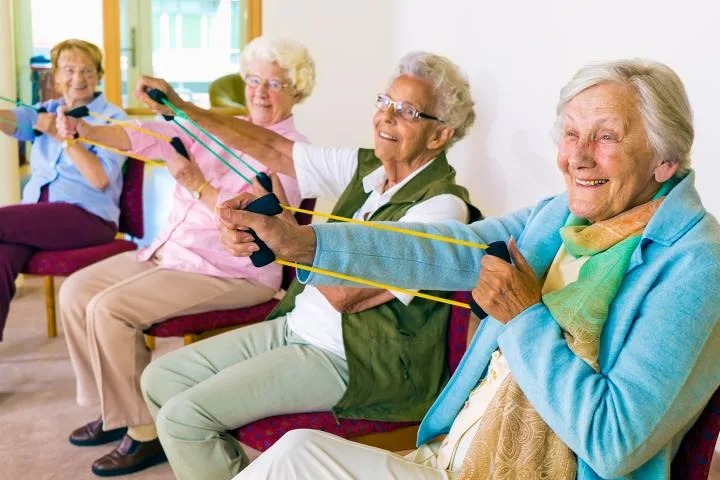
If you’ve ever come upon a news story, or perhaps a documentary on how to live to 100 on your favorite streaming channel, featuring a Centenarian’s advice and quickly dived in to learn their secrets for healthy aging, you are not alone. It’s natural to want to shine through the golden years!
Life expectancy around the world has been on a generally upward curve for centuries. In 1900, life expectancy was only 47.3 in the United States, while in 2022, it was 77.5 according to the Center for Disease Control. A little increased focus on some key areas of lifestyle is likely to bring rewards now and later for a life lived to the fullest, including social connections, physical activity, diet, and oral health
Areas of Focus for those wishing to live longer, healthier lives!
This article is for informational purposes only and should not be considered medical advice. Check with your care physician before making any lifestyle changes that may affect your health. Individual recommendations may vary based on health, conditions, and medications.
Social Connections
A healthy living component that is repeatedly in the news is maintaining strong social connections, and for good reason: those who are actively socially connected lower their risk for heart disease, stroke, dementia, and depression – and increase their ability to deal with stress and issues of daily life. Getting more social, even in tiny steps, is a step in the right direction.
3 Simple Ways to Improve and Maintain Strong Social Connections as an Older Adult:
1) Increase your net of friends by trying new activities that involve a group, such as taking part in a club or attending a class.
2) Maintain strong social connections by checking in on friends regularly. Perhaps sit with groups of people at mealtimes or schedule regular coffee dates with friends you’ve made.
3) Sometimes you can be surrounded by people and still feel alone. Doing something that makes you feel you are connected to the community can aid in building meaningful connections, like volunteering or heading up activities! This will help you find people like yourself and aid in a sense of purpose and belonging.

Physical Activity
Staying physically active is an area we should always put effort toward, no matter our age, though effort types and amounts should differ. When we reach 65 or older, our bodies need aerobic, strengthening, and balance activities to stay strong. Beyond that, regular exercise can prevent or delay many health problems that come with age. It may be encouraging to know that any amount of effort put toward exercise is better than none. Health benefits should increase as (safe) physical activity does.
Surprising Health Benefits of Regular Physical Exercise in Seniors
While we know that physical exercise can help with cardiovascular health and may even help prevent or slow dementia symptoms. There are some benefits to maintaining a regular exercise schedule for older adults that you may not know about, including:
- Bone loss prevention (that comes with age)
- Chronic disease prevention or reduced symptoms of existent chronic diseases
- Boosted immunity
- Mood Enhancement
As for how much physical activity to do, consult your doctor for your specific best plan. A good rule of thumb for fitness goals in those aged 65 years or older, following CDC guidelines, includes:
- A senior should aim to get 150 minutes (about 2 and a half hours) a week of moderate-intensity activity (such as a brisk walk). The time should be broken up throughout the week and day, it could be broken into 30 minutes a day, five days a week for instance.
- Older adults should also aim to do muscle strengthening and balance activities two days per week.
- One exercise session in the day may not be the best route for an adult who should aim to break up extended periods of sitting or lying down with movement. (Read our post sharing our Must Know Fitness Tips for Seniors!)
Those with chronic conditions are advised to be as physically active as abilities and conditions allow. Chair yoga, Tai Chi, and swimming can be wonderful exercise choices.

Diets for Older Adults
Diet is another top contributor to overall wellbeing. Eating well can boost immunity, support muscles, strengthen bones, and lower the risk for heart disease, type 2 diabetes, and some cancers. In general, focusing on fruits, vegetables, whole grains, and dairy while cutting added sugars, saturated fat and sodium can improve one’s diet. Getting enough Protein is also important for older adults, meaning approximately .45 grams per lb or approximately 68 grams of protein for a 150lb senior.
A nutritious diet has also been proven to aid in overall brain health! Following a well-rounded diet can help with brain function and even decrease cognitive decline. Read our blog on Brain Health to learn more about this benefit and learn about the most recommended diets for brain health.
Oral Health
Oral health should also be a priority. Did you know that oral health and overall health both affect each other? The 2020 Surgeon General’s Report on Oral Health findings show that the mouth reflects overall health and well-being, and that oral conditions are associated with health issues. Seniors missing regular dental visits tend to be in just fair or poorer health than those who did see a dentist. If a dental visit is not in your planner for the year ahead, make a goal to get one scheduled.
Resource: Read our blog, Senior Smile Savvy, to learn quick dental health tips to implement today!

While these four areas are great to focus on to start the process to living a longer, happier, and healthier life, there are many more areas that also contribute to this mission! Attention to sleep, skin, vision, and hearing are a few added areas of lifestyle to explore improvements. Let us know in the comments what health areas you tend to focus on and how they have impacted you!




